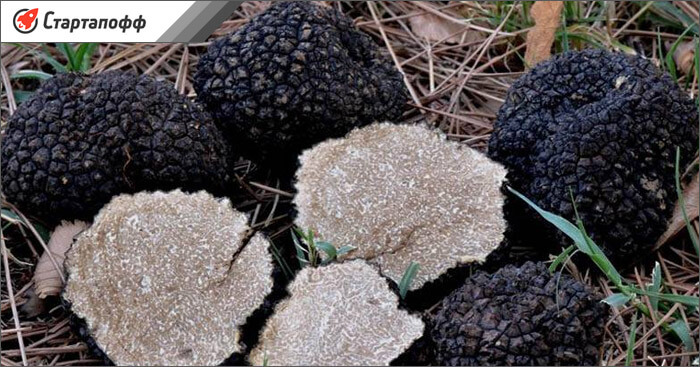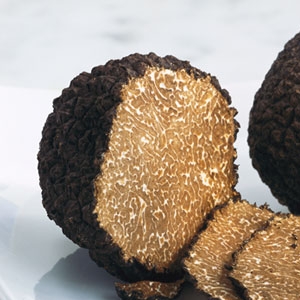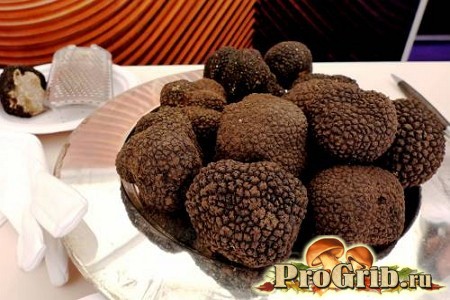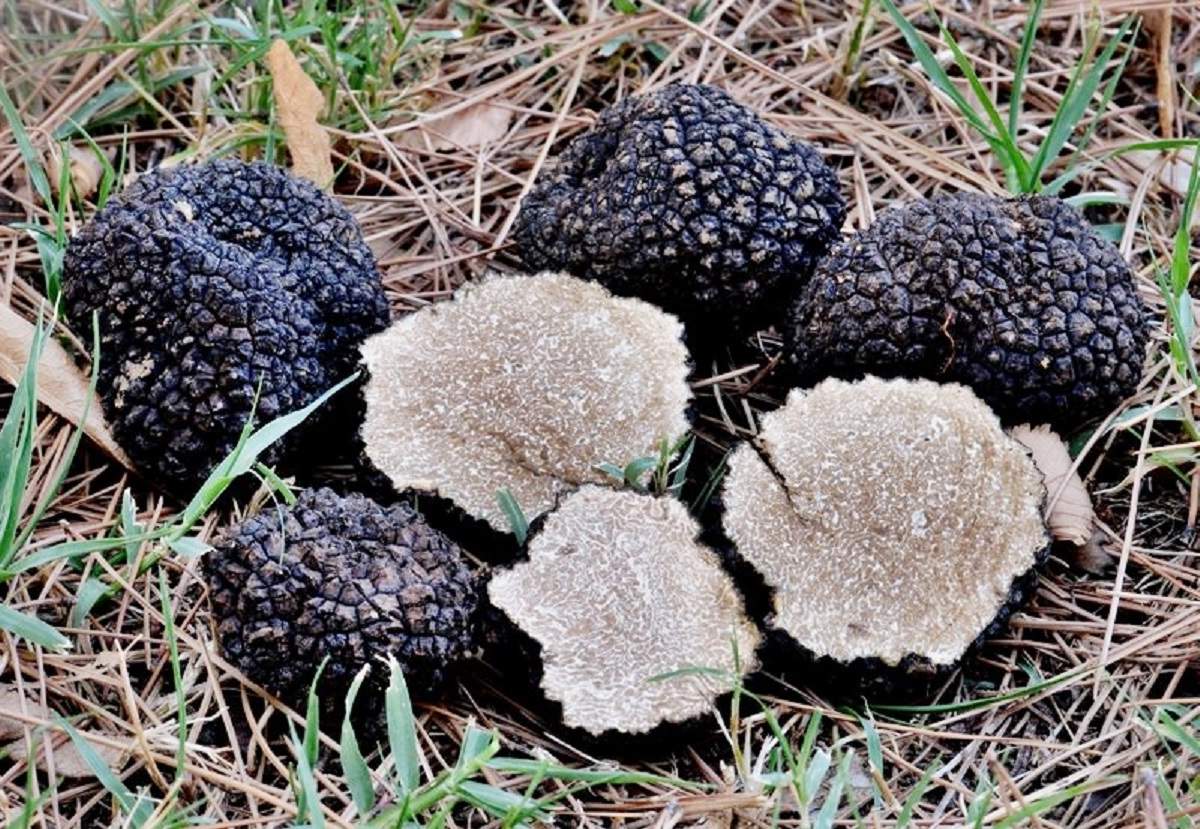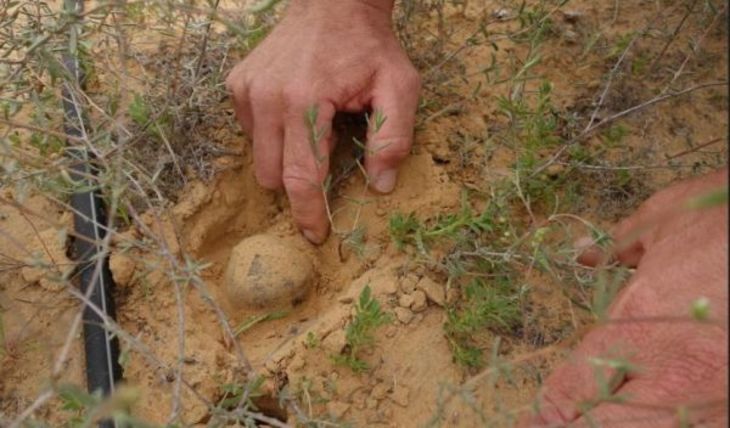How to grow a truffle in the country
Most often, black truffles are grown at home. First you need to purchase its mycelium. The stages of cultivation are the preparation of a site or a greenhouse, infecting a tree seedling with mycelium and maintaining optimal conditions for 3-4 years.
Trees for symbiosis with truffle mycelium are English oak, stone oak, common hazel. Only seedlings are suitable for replanting mycelium, young seedlings are no longer used.
The introduction of mycelium into the culture medium is called inoculation. It is better to acquire a ready-made symbiosis than to try to make it yourself. Mycelium infection lasts 1 year and is a very troublesome process.
Inoculated seedlings are planted in a pre-prepared area. How to make growing soil for seedlings:
1. The soil is taken only from the deciduous forest, and it is necessary to remove the soil layer with leaves. 2. The soil from the sprout is added to it - it speeds up adaptation to a new place. 3. A little sand and fresh sawdust are also brought in. Looseness and good aeration are one of the conditions for successful truffle cultivation.
Sprouts with mycelium are planted in a permanent place when they reach 20 cm. Planting is carried out strictly after the threat of spring return frosts has disappeared. The air must be warm enough for the mycorrhiza to be comfortable. The temperature is around 23 degrees.
The depth of the planting pits is 25 cm. A distance of 1 m is observed between the holes. The soil on the site must be fertilized in the fall, at least six months before planting the truffle mycelium. Fertilizing during planting inhibits the mycelium.
The roots should be handled with extreme care so as not to damage them. After moving the mycorrhiza, a little water is poured into the holes, everything is covered with a layer of hay and sawdust
While the sprout will adapt to new conditions, quarantine is required. This period will take at least 1 month. Only under sterile conditions does the mycelium finally take root.

White truffle only grows in the wild
Truffle growing technology
Several types of truffles are artificially bred - white, black and Chinese. But it cannot be said that the cultivation of white truffles is something particularly different from the cultivation of black types of mushrooms. The difference here is more precisely in the taste characteristics of the finished product. Accordingly, the selling price of truffles will vary slightly.
If possible, start by growing black mushroom - it is more valuable on the market. This will save you from a long search for buyers in the future. The cost of mycelium ranges from 300 rubles / 100 g. It is sold in a special substrate, which can be immediately planted on the site. Buy seed from a trusted seller!
Is it possible to grow a truffle in the conditions of your own plot? Of course! The first stage of the technology is the deepening of the mushroom mycelium. When planting mushrooms, you must adhere to the following rules:
The optimal time for disembarkation is May-August. Everything is individual here - the mycelium will take root if a stable high temperature has already been established on the street, and the threat of frost has passed. It is better to plant the black truffle mycelium according to the 2 * 2 m scheme. The depth of the holes is 20-60 cm. It all depends on the mycelium purchased - the optimal planting depth should be checked with the seller. If it is planned to grow mushrooms in a wooded area with young trees, the seed material is deepened along the perimeter of the tree root system. Before planting the white truffle mycelium, the hole is filled with a little water and half filled with prepared compost. Seed material is laid on this nutrient layer. Then the hole is covered with earth, again watered with water and well compacted. Often, planting sites are watered with special preparations.
This is especially important when cultivating truffles in greenhouse conditions - then the composition of the soil will be close to natural. In order for the seeds of truffles to give a harvest in the future, the planting sites must be mulched.
To do this, use straw or sawdust, fallen leaves. Mulch layer - 15-20 cm.
The rules are:
For the winter, plantings must be mulched.
This is especially important if the mushrooms grow in natural conditions - so they will not freeze in the cold. If truffles grow in forests, they should be protected from "pests" - these are rabbits and wild boars.
Animals can negate all your efforts to grow the gourmet mushroom. Make sure that they do not enter the territory of the "farm". To increase and accelerate fruiting, substrates are used as soil fertilizers that can increase the number of microorganisms in the soil. If the mushrooms were planted near trees, you need to fertilize the plants themselves. Throughout the growing period of truffles, it is necessary to ensure that there are no weeds on the site. They can be controlled with herbicides.
Harvesting is probably the most enjoyable part of the truffle growing process for an entrepreneur. Their edible part, which you will begin to realize in the future, is the fruiting body of mushrooms with spores. Ripe black truffle is a slightly elongated or rounded mushroom with a dense dark-colored shell.
Truffle digging should be done carefully.
It is important not to damage the fruiting body of the fungus! Otherwise, the price for 1 kg of black truffle will be slightly lower - the product will become "illiquid"
Judging by the experience of entrepreneurs, up to 10 kg of truffles can be harvested from one hundred square meters of land per season. Considering how much a kilogram of truffles costs, the earnings from the sale of finished products will be pretty decent. But this is provided that during the few years that you have been caring for the plantings, some of the mushrooms will not die.
Australian cultivation technology
Australians know what and how to do to grow a fragrant truffle at home. Their technology has been the most successful since 1995. In a year, 1 hectare will yield a crop of 4 kg, and in 5-6 years - up to 20 kg.
This method has been successful for over 20 years both in Australia, where truffles have never been available, and in other countries. Moreover, it will be effective in Ukraine, where mushrooms grow in the wild anyway. Of course, material costs and constant efforts are required, especially in the early years. But then everything will pay off with interest, given the current cost of mushrooms.
The more common mushrooms for cultivation are champignons.
Infection
For this purpose, common hazel and oak and pedunculate oak, which are common in Ukraine, are suitable. The seedlings of these trees are better suited for infection than young seedlings, since they initially develop not the stem, but the root faster. Mycorrhiza will develop along with it.
For infection, you need to buy a black truffle mycelium and process the seedlings with it. They are left for a couple of weeks under sterile conditions, allowing the mycelium to take root. After that, seedlings are planted in a plot with prepared soil. Finally, mycorrhiza takes root within a year, until the sprouts reach 20 cm in height, and the roots are 50 cm in length. All this time you need to adhere to quarantine.
Planting seedlings
Seedlings infected with truffle mycelium can be planted outdoors in late spring. The soil must be pre-treated with herbicides with ammonium glufosinate (it quickly decomposes in the ground).
Important! You cannot introduce fertilizers before planting the sprouts, as this is detrimental to the mycelium.
Each seedling should have enough space, no more than 500 pieces per hectare. It is advisable to adhere to the scheme - 5 by 4 m. The depth of the hole is at least 75 cm, so the root of the tree will be protected from frost and pests. Water is poured into the hole, the sprout is covered with earth, compacted and watered again.Mulch from the forest land with last year's leaves in a radius of 40 cm is poured under each plant and this area is covered with a film.
Truffle care
The first two years after planting, you need to maintain the sterility of the site. This requires weed control. The appearance of the main pests - rabbits and pigs, as well as insects dangerous to fungi - weevils and black cockroaches should not be allowed.
Top dressing is done with a complex NPK fertilizer and a small amount of micronutrient fertilizer - iron, magnesium, zinc, boron and copper.

Important! For truffle oaks, the neighborhood with willow, poplar, chestnut, fir, spruce, pine and lime is dangerous.
Truffle characteristics
Before you start growing this mushroom, you need to familiarize yourself with its morphology.
Appearance
Belongs to the class of marsupials, the truffle family of about 30 species of mushrooms. They belong to the mycorrhizal, which are in symbiosis with the root system of trees. Basically, oak acts as a partner tree.
Main characteristics:
- the shape of the fruit bodies is tuberous or round, resembling a potato;
- fruit size - from 2.5 to 20 cm;
- weight - from 20 to 200 g;
- surface relief - smooth or with pyramidal warts and cracks;
- color - from black and chocolate to white, gray and marble;
- pulp color - white, gray, yellow-brown;
- fruiting period - from 25 to 30 years;
- the shelf life of the cut mushroom is from 2 to 4 days.
The marble structure is clearly visible in the cross section. The flesh of a mature truffle is loose, while that of a young truffle is firm. It is slightly larger than a walnut in size, but some varieties weigh more than 1 kg. It grows at a depth of 25-30 cm, forming nests with 5-7 fruiting bodies.

Vegetation period
To understand the technology of growing truffles, you need to have an idea of the peculiarities of the growth of the mushroom. This will help provide quality care at every stage of its development. Novice mushroom pickers should learn 2 key concepts related to their growth.
 Truffle is an underground mushroom
Truffle is an underground mushroom
 Mushroom growth
Mushroom growth
Small buds located in the upper part of the mycelium turn into fruiting bodies. This process takes 4 to 8 months.
Growth features
This invisible mushroom prefers to grow in the ground. Only old truffles appear on the surface occasionally. Loves mixed and deciduous forests with calcareous soils. It practically does not reproduce in conifers. Necessary proximity to beech, oak, hornbeam, walnut or birch.
 Unlike other mushrooms, truffle spores are not spread by the wind.
Unlike other mushrooms, truffle spores are not spread by the wind.
Types of truffles
The truffle family includes many edible species.
Table 1. The most popular varieties
| View | Country or region of growth | Collection time |
|---|---|---|
| White piedmontese | Piedmont and Tuscany in Italy. | October to December. |
| Black perigee | Perigueux in France. | December to March. |
| Scorzone | In the Alps. | August to September. |
| Burgundy black autumn | France, Italy and North Africa. | October to December. |
| Black musky | Europe excluding the eastern region. | November to March. |
| Black Russian or summer | Transcaucasia, Crimea and the European part of Russia. | June to October. |
 White truffle is considered the most expensive truffle variety
White truffle is considered the most expensive truffle variety
In Russia, the easiest way to cultivate a summer truffle is listed in the Red Book.
 Deer truffle
Deer truffle
Mushroom picking
Due to the fact that the fruit part is completely submerged in the ground to a depth of 15 cm, it is not possible to find a truffle on your own.
 The search for mushrooms is carried out using specially trained animals
The search for mushrooms is carried out using specially trained animals
Pigs or dogs are used for search operations. The latter are used more often. Boars can smell truffles up to 10 meters away. Four-legged pets also have a good sense of smell, but the process of training them takes a long time. Mushroom picking is done at nightfall.At this time, the air becomes cleaner, and animals better locate the delicacy.
 Yellow swarms of truffle fly circling in the truffle area
Yellow swarms of truffle fly circling in the truffle area
Truffle cost
On the European market, the price for 1 kg of white Piedmontese reaches 8,000 €. Black Perigorskie cost from 1,300-2,150 € per 1 kg. Black Russian costs about 400 € for 1 kg. The high cost is typical for mushrooms harvested in natural conditions.
 White truffle is more expensive than gold and black caviar
White truffle is more expensive than gold and black caviar
Conditions for growing truffles in Russia
Under natural conditions, only one type of truffle grows on the territory of Russia - summer truffle. Distribution areas - southern mixed forests. The most valuable varieties - white and Perigorsky - grow only in greenhouses or after infection with mycelium of trees on the site.
To grow a truffle at home, you need to clearly know what conditions are optimal for the fungus: 1. Soil, the acidity of which is close to neutral. The pH level should not be lower than 7.5. 2. The priority is calcareous soils - they are rich in calcium, which mycorrhiza loves. 3. In nature, the truffle grows in mixed forests, in conifers it is extremely rare. 4. Optimum air temperature - 20-22 degrees Celsius, soil - 15 degrees. 5. Optimum air humidity - from 85%.
Before you start growing truffles at home, you need to familiarize yourself with the concepts of mycorrhiza and mycelium: 1. Mycelium is the vegetative part of the fungus, reminiscent of fluff. It is attached to the roots with long thin threads. 2. Mycorrhiza is a symbiosis of the mycelium and the root system of the tree. Both parts benefit from the union: mycelium - nutrients, roots - moisture. Truffle mycelium does not live without a tree.
The mycelium must penetrate the roots for the truffles to mature in a few years. This happens after 3-4 years, after 6 years you can get a marketable mushroom. Mycorrhiza will bear fruit for up to 30 years if all the necessary conditions are met.
Methods for growing truffles in the country
Algorithm for growing truffles in a greenhouse
- Loosen the soil.
- Apply fertilizers a season or two before planting, or not apply them at all.
- Divide the soil into 4x4 meter squares.
- Pick up a tree sapling. Both oak (stone or pedunculated) and spruce, pine, fir, hazel, flax or sequoia may be suitable.
- To buy mushroom mycelium, experts recommend choosing a French black truffle for growing with a seedling.
- Infect seedlings with mycelium.
- Dig at least 70 cm holes for the seedlings.
- Fill the holes with water.
- Plant a seedling with mycelium in the hole.
- Cover with soil.
- Carry out mulching (lay at least 40 centimeters of soil with remnants of dry leaves).
- Cover the space within a meter of the tree with polyethylene.
- Water the trees regularly and feed them with NPK fertilizers.
- Soil preparation.
- Application of a nutrient solution of water and NPK fertilizers containing calcium, boron, bromine, potassium, magnesium, etc.
- The mycelium is mixed with a little soil.
- A layer of previously purchased sawdust or chopped wood is covered with the resulting substance.
- The resulting product is left in sterile conditions for a month.
- Stable room temperature and humidity, soil moisture are maintained.
- Watering as it dries in moderation.
- Avoid the emergence of any weeds or pests.
- Use herbicides as a means of getting rid of unnecessary organisms.
Truffles bear fruit underground, so their harvest is deep in the soil. The first crop can be harvested a month after planting, but this value is minimal, since it may take a year for the mycelium to fully take root. Experts note that the truffle harvest is small in the first 2-3 years. The highest volumes are achieved in the third, fourth, and even fifth year of their cultivation.
Hypertension is latent. Recognize in time
A recent study found that latent hypertension, which is not recognized during routine physical examinations, increases the risk of heart attack and stroke. For its timely detection, it is recommended to regularly measure the pressure at home.
Many people have normal blood pressure readings in doctors' offices, but high blood pressure at work or at home. Research shows that home monitoring can help identify these people.
A new study, which involved more than 5,000 people from four countries, found that people with this type of latent hypertension have an increased risk of heart attacks and strokes. But the good news is that home blood pressure monitoring helps to recognize this phenomenon and take preventive measures.
It is known that cardiovascular diseases often occur in people with normal blood pressure. But after all, most people measure blood pressure only during medical examinations.
By asking the volunteers to measure their own blood pressure at home, Steissen wanted to know what other factors influence the risk of developing heart disease. Initially, it was planned to study patients with so-called "white coat hypertension" - the opposite syndrome, in which there is high blood pressure during a medical examination, but normal at home.
Studies have found that latent hypertension increases the risk of heart attack and stroke by 55%, while white coat syndrome increases the risk by 42%. Even when compared to patients undergoing treatment for high blood pressure, latent hypertension increases the risk by 76% - probably because patients with this type of hypertension are not receiving the treatment they need.
Steissen adds that regardless of the diagnosis, those with risk factors - smokers, obese people, the elderly - should regularly monitor their blood pressure at home to detect high blood pressure early.
How to grow truffles at home
Unfortunately, the climatic conditions of most of Russia are very different from the weather conditions of Southern Europe, therefore, it is most likely that it will not be possible to grow a truffle from mycelium in the Moscow region using the method described above. And besides, not everyone has the opportunity to plant their own oak grove on the site. In this case, you can try growing a truffle under a single tree, and in areas with unfavorable climates - in the basement of a house or a greenhouse.
How truffles are grown under trees
You can grow a truffle yourself under a tree. In regions with warm summers and mild winters, such an experiment may well end well. To do this, you will need to plant a seedling, into the roots of which the truffle mycelium has already been inoculated. Such planting material can be purchased online or in specialized stores.

Most often, suppliers offer Lebanese cedar, hornbeam, pedunculate oak, stone oak, Atlas cedar, Aleppo pine, bear hazel, European beech for cultivation as seedlings.
Young seedlings are sold, as a rule, in containers of various capacities (depending on their age). After purchase, the tree is planted in a prepared area. Under favorable conditions, the harvest of mushrooms can appear within the next 3-5 years.
Important! The garden area where truffles are grown must be completely secured from the access of domestic animals, especially rabbits and pigs.
How to grow truffles in a greenhouse
The greenhouse can be used to simulate weather conditions in regions where the climate does not allow growing truffles under trees. This will require significant financial costs for special equipment, arrangement of heating and air conditioning systems, as well as soil preparation.It needs to be cleaned of roots, stones, to ensure a normal level of acidity and the presence of necessary trace elements.

Sawdust of various deciduous tree species, primarily oak and beech, is used as a nutrient medium for growing mushrooms. They are infected with truffle mycelium and placed in a sterile environment until mycorrhiza forms. This can take up to 1 year. After the mycelium develops, it is planted in a greenhouse, in a prepared soil substrate.
Landing is carried out as follows:
- Depressions of the order of 0.5-0.6 m are made in the ground, placing them at a distance of 1-2 m from each other.
- The pits are spilled with water and a layer of humus is added to them.
- Sawdust with a truffle mycelium developed on them is laid out on the holes, about 1 handful for each hole.
- From above, the mycelium is covered with hay or sawdust.
Important! To reduce the time, you can purchase a ready-made substrate from sawdust with a developed mycelium for growing. In the greenhouse, you constantly need to maintain conditions close to ideal
The ambient temperature should be about + 22 ° С, and the relative humidity of the air should be 55-60%. In winter, the soil should be mulched with peat for additional thermal insulation.
In the greenhouse, you constantly need to maintain conditions close to ideal. The ambient temperature should be about + 22 ° С, and the relative humidity of the air should be 55-60%. In winter, the soil should be mulched with peat for additional thermal insulation.
How to grow truffles in the basement in the country
Growing truffles at home all year round is possible when using, for example, the basement of the house. To do this, it must be equipped with the same systems as the greenhouse. Basements are more preferable for growing not only truffles, but any mushrooms in general, since they have much greater inertia. They keep the parameters of temperature and humidity more stable, in addition, there is no need to take measures to limit the excess of sunlight.
Important! Basements where mushrooms are grown must be equipped with ventilation systems and monitoring the level of carbon dioxide. CO2 accumulating in the process of decomposition of organic residues is heavier than air, it can gradually fill the entire basement, and this can be life-threatening
CO2 accumulating in the process of decomposition of organic residues is heavier than air, it can gradually fill the entire basement, and this can be life-threatening.

For the convenience of work, it is advisable to zone the inner space of the basement, that is, to divide the places where the mycelium is grown and the mushrooms ripen directly. Before starting work, the room is equipped with racks to accommodate containers with a substrate, and it is also disinfected.
Where and how truffles grow. How to grow a truffle
In the wild, truffles grow in deciduous and mixed forests. On the territory of the Russian Federation, their habitat is the Black Sea coast, the Caucasus, and the Crimea. The growth period is November-March.
If we talk about home growing conditions, then in relation to Russia, the following options are possible:
- outdoors - the most affordable way. Ideal for warm climates. It will not work to get a harvest in Siberia in this way. As a last resort - the European zone of the country. Some argue that the royal mushroom (also called the truffle) can be found in the Moscow region;
- in greenhouses. In this case, there is no reference to the climate and temperature extremes. The disadvantage of this method is large investments at the start. A high-quality greenhouse will cost at least 400,000 rubles;
- in basements - the most expensive and risky option. We'll have to provide the temperature background, create the required humidity, equip the ventilation system. You will need the right lighting. The prime cost of the crop grown in basement conditions is 2 times higher than in greenhouses, and 3 times higher than in open ground.

Physiology of taste
Even in ancient Rome, people admired the greatness of this mushroom. It was even considered healing, used by physicians of that time to prepare means aimed at improving "men's health". It was believed that he is able to give a person unthinkable strength, endurance. In the Middle Ages, it was believed that truffles have mystical properties, capable of giving a person supernatural strength.
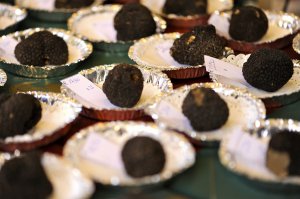
Truffle has been considered a special delicacy since the 15th century AD. It was then that Italian chefs began to use this unsightly irregularly shaped mushroom in their dishes, which they called tartufo ("tuber"). At the same time, French chefs from the central regions of the country began to use truffles for cooking, but they did not position it as a delicacy, but considered it simply a “filler”. Then truffles began to be harvested in Russia, in the Moscow province. According to legends, some especially cunning "hunters" attracted bears to their hunt, which had their teeth pulled out beforehand, since they found underground mushrooms much easier.
Truffles were grown artificially in France only in the 19th century. Then there were whole "truffle forests" in every region of the country. They were available to almost any ordinary citizen at the festive table. At the same time, the famous chef Jean-Anselm Brillat-Savarin wrote his still popular book "The Physiology of Taste", in which he devoted an entire chapter to the "diamond of the kitchen" - truffle, describing both its taste qualities and the qualities of an aphrodisiac.
However, the First World War, coupled with the deterioration of the environment, had a very bad effect on the cultivation of truffles in France. And, if until the XX century 100 tons of mushrooms per year were collected only from the territory of one region, then after the First World War the annual truffle harvest in the whole country has not yet exceeded 20 tons.

